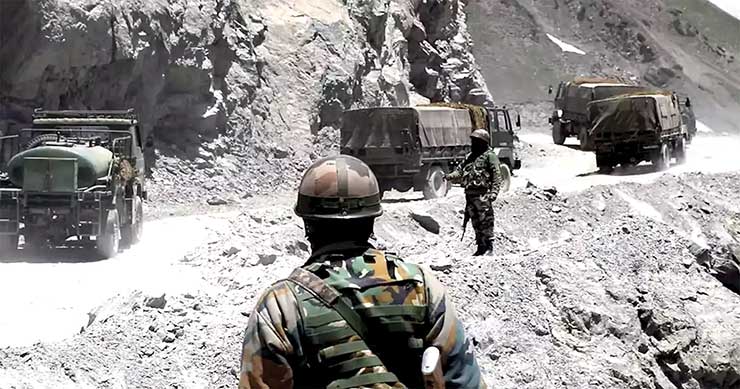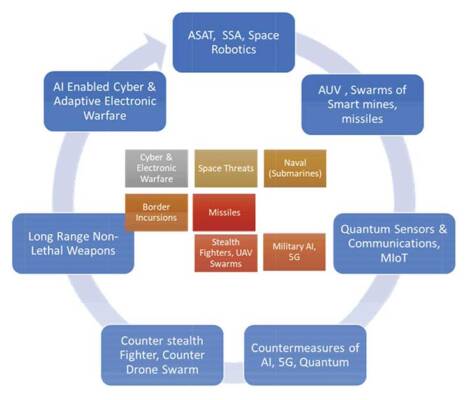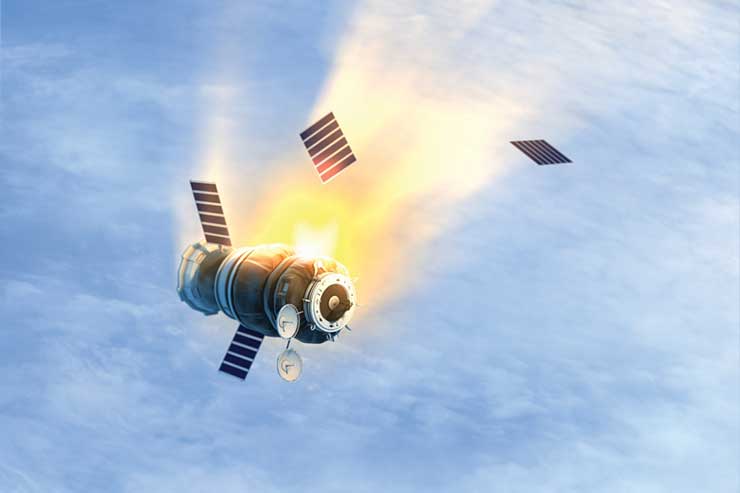
India’s security threats range from ‘two-and-a-half’ front war comprising of coordinated aggression by Pakistan in the West, China in the North and internal insurgencies in J&K, North East and Maoist / Naxalite violence, growing Chinese Navy activities in the Indian Ocean and COVID-19 pandemic. While India is effectively dealing with challenges of Internal Security, Pakistan and COVID-19, it requires effective strategy to counter China which has large economic, military, technological and manufacturing lead over India, and emerging as Global leader in many military and commercial technologies.
Meeting our National security objectives despite these gaps and our budget constraints require that most cost-effective technologies must be selected that create maximum multiplier effect for our military, and most debilitating effect on our adversary by threatening his most valuable assets. We require Quantum jump in innovation and speed of innovation to develop cost effective, offensive and defensive multifunctional platforms, weapons and systems, adaptive against counter strategies.
India’s ASAT testing provided deterrent to China counter-space capabilities, which needs further enhancement to MEO & GEO orbits, killer microsatellites and Directed Energy Weapons development. Space Situational Awareness (SSA) and Space robotics will enable both defensive and offensive capabilities.
China’s deployment of Stealth Fighters requires System of System solution to detect and guide missiles including VHF / UHF/ L-Band Phased Array Radars on AWACS, UAVs and Mobile platforms. China’s large arsenal of missiles requires matching with our long-range, loitering missiles and Vertical/short takeoff and landing (V/STOL) aircraft.

China’s large drones and drone swarms are grave threat. India has already demonstrated Anti-drone systems, thrust on counter drone swarm technologies development like long-range high-power microwave directed energy weapons.
Chinese naval threat including submarines require multi-static sonar, AUVs for Anti-Submarine Warfare (ASW), swarm of smart mines, swarm of small missile boats, and swarm of Missiles to sink Aircraft carrier that will threaten its Naval presence in Indian Ocean Region (IOR).
Chinese border incursions require development of long range non-lethal weapons to warn advancing PLA soldiers, for example Stun grenades launched from drones, microwave weapons to make them dizzy and sick and millimeter wave weapons to cause burning sensation.
Artificial Intelligence, the biggest military multiplier in all domains of warfare, needs application in every weapon, platform, Network, and from Soldier to Military enterprise. AI integrated with 5G
and Military Internet of Things (IOT) will enable smart bases, soldier healthcare, battlefield awareness, C4ISR and fire-control systems. In fire-control systems, sensor networks with digital analytics will enable fully automated responses to real-time threats and deliver firepower with pinpoint precision and Networked Munitions to track mobile targets or be redirected in flight.
Ever-increasing cyber-attacks and cyber warfare campaigns demand development of Autonomous Cyber AI for Defence and AI-driven extreme cyber weapons. Electronic Warfare systems adaptive against threats, scalable from Jamming to Electronic Attack to target Space, Ground and Sea targets using land, air and sea-based platforms while hardening our own platforms and weapons.Future Soldiers require enhanced lethality, survivability, situational awareness and network capability including wearable nano sensors, mixed reality goggles, integrated teams with unmanned ground and Air vehicles including man-portable swarming munitions.
Intelligent multi-domain capability integrated into platforms, weapons, and C4ISR Networks generating automatic intelligent responses, attacking adversary in its most vulnerable areas, and overcoming counter-measures.
Thrust on propulsion technologies including electric, hypersonic and nuclear will be enabler of Next generation platforms and weapons in all domains. New materials and electronics and that can function in extreme environments such as Hypersonic flights, Deep-space environments. Metamaterials are enabling military sensors, antennas, optical, radar and acoustic cloaking, and wireless charging.

China is competing against US for full range of Quantum domain i.e. Quantum (Communication, Computers and Sensors). This includes race for Quantum supremacy in Quantum computers which cost hundreds of billions of dollars, and whose military utility is yet to be established. Indian Military for maximum multiplier effect needs to provide thrust on Quantum sensors including Quantum radars to detect stealth aircraft, Quantum magnetometer for submarine detection and Quantum Communications (QKD) for tamper proof battlefield communications. All expensive technologies like Quantum Computing need to be pursued through International collaborations with our allies to reduce costs.

Commercial technology innovations drive and precede military innovations by many years. One way to enhance the speed of innovation is to start early in exploiting Cloud computing, 5G, big data analytics, autonomy, robotics, photonics, synthetic biology, 3D printing to quantum technology. Military needs to act while these emerging technologies are launched commercially, importing and making them available to Indian Scientists to develop their military use cases as well as develop countermeasures.
For example, emerging Terahertz technologies will provide revolutionary capabilities including Secure 6G communications, Chemical and Biological Agent detection and anti-stealth ultra-wideband radar. Countermeasures include jamming Terahertz, fooling AI, damaging quantum communications by laser. New Countermeasure centre needs to be established to access military impact of every new commercial technology and dissecting every adversary system and developing effective countermeasures against them.
Neuro-cognitive technologies enhancing our Soldiers combat effectiveness physically, perceptually, and cognitively and degrading adversaries. Synthetic biology for biological and chemical defence, bio-production of military drugs, materials, food, fuels, and sensors to gene manipulation for building super soldiers.

3D printing to manufacture parts, ammunition, drones, naval vessels, fighter aircraft to food and human organs and Implementing Industry 4.0 and Supply Chain Risk Management (SCRM) in Defence Industry is need of the hour. Ultimately, in Defence exports, if Chinese exported weapons have poor quality, we need to develop Quality as a weapon.
–The writer is Founder Director of International Defense Security & Technology Inc., a non-profit organisation in San Jose California (www.idstch.com). He was also Director (System analysis, Safety, Quality and Reliability), DRDO, New Delhi. The views expressed are personal and do not necessarily reflect the views of Raksha Anirveda








